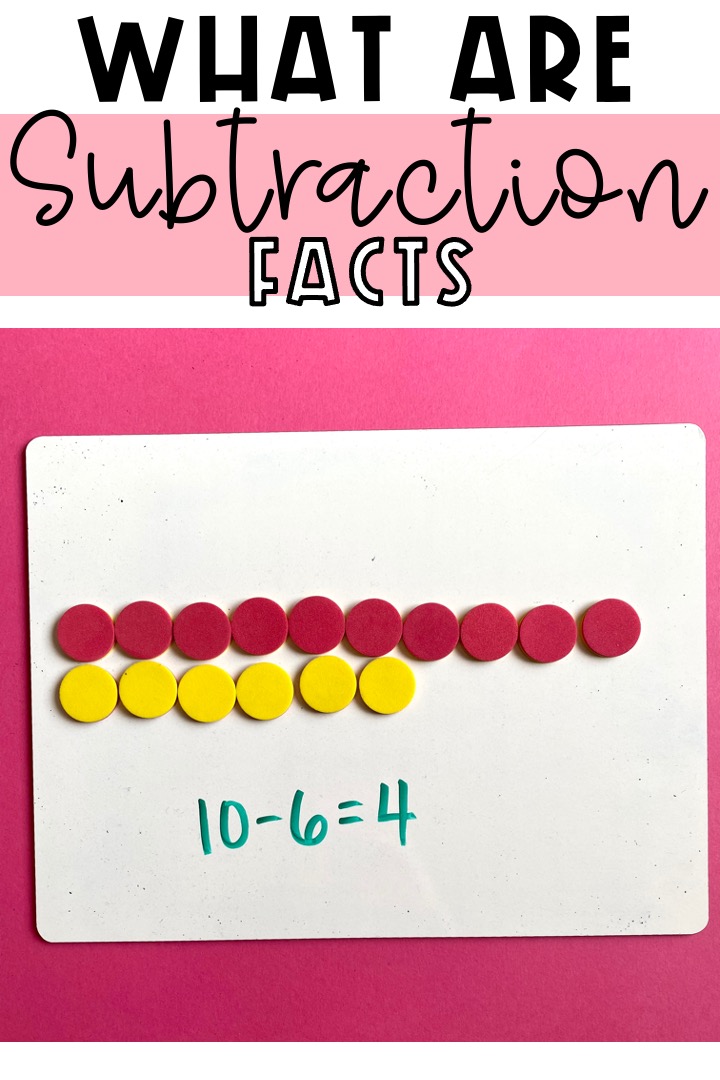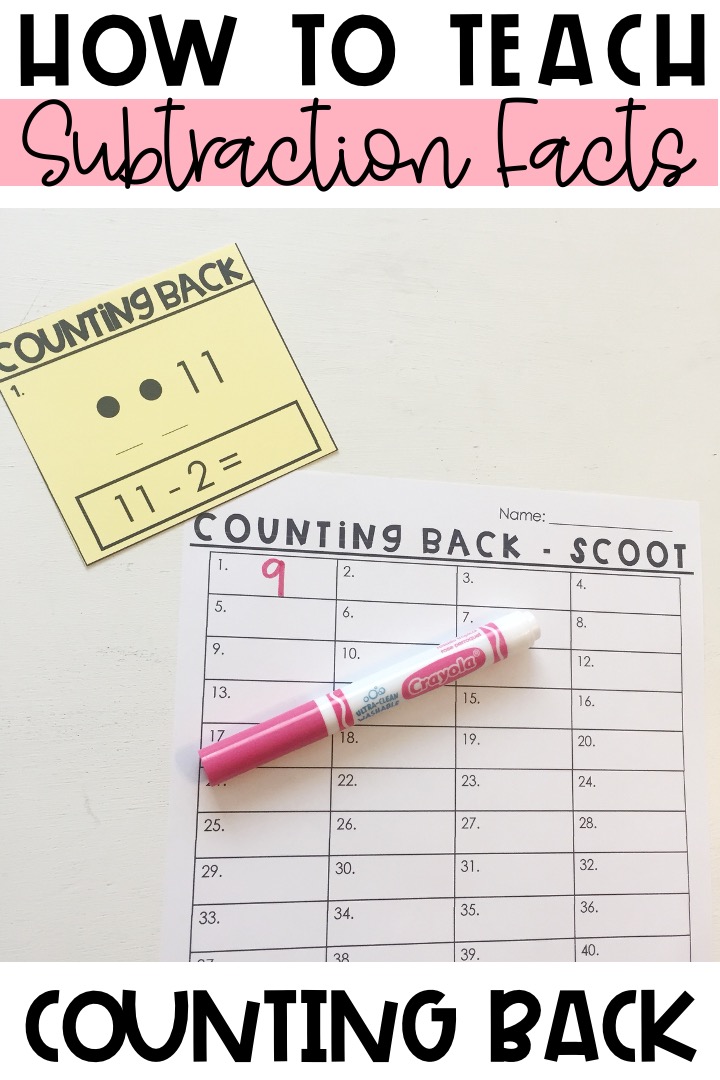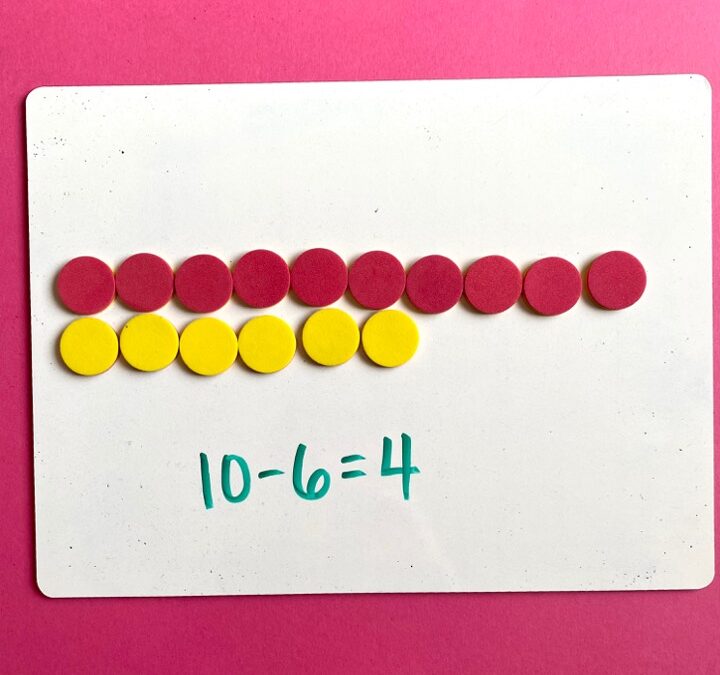Addition is usually pretty easy for students. They quickly understand that addition means add to. Subtraction is the inverse of addition and it can be harder for students to catch on to. Today I’m sharing what are subtraction facts and what’s the best way to teach them.
What Are Subtraction Facts
According to the common core standards, 2nd grade students should learn subtraction facts within 20. They should know them fluently while 1st graders should know facts through 10 fluently and should use strategies to figure out facts through 20.
For subtraction facts, that means the minuend should be less than 20 and the subtrahend should be a one-digit number. The difference, or the answer to the subtraction equation should also be a one-digit number.
Let’s look at some examples. 13-5=8 would be a subtraction fact, but 19-4=15 would not.

Once we understand what are subtraction facts, we can help our students learn them in a way that helps them build number sense and gets them to math fact fluency.
How to Teach Subtraction Facts
Use Counters
You want students to see that subtraction means taking away. I start with an equation like 7-2. I set out 7 counters and then have students take 2 away. Students see that how many are left is the answer.
Students also need to see that subtraction means the difference. I give them an equation like 10-6. I lay out 10 red counters in line. Right underneath those 10 counters, I line up 6 yellow counters. Then I ask students “what’s the difference between these two numbers?” Students can see that there are 4 more red than yellow, so the difference is 4.
Let students use counters on their own to continue to discover the answers to different math facts.
Use a Number Line
Once students understand what subtraction means by using counters I like to introduce them to using number lines to subtract. First, I model to students how to count back to subtract on a number line. With an equation like 9-3, I start at 9 and make 3 jumps back. What I land on is the answer. So 9-3=6.
Then I give students plenty of practice with this strategy. I have them work with a partner and do a scoot activity around the room. I layout subtraction problems around our classroom and then have students go around solving them. They can use a dry erase marker on the laminated task cards or solve it on the number lines included on the recording sheets.

As students work with their partners, I walk around and give support to students as needed. I even hang up an anchor chart to help students when they are stuck. Find these task cards and anchor chart here.
I will give students more practice by having a subtraction number line worksheet included in a math center. Finally I’ll see how much students understand this strategy with an exit ticket. Find the worksheets and exit tickets I use here.
Counting Back
Once students understand how to count back on a number line, I teach them how to count back without using a number line. I do this by modeling to students first. For the equation 11-3, I put my fist out and say the starting number, 11. Then I count back while putting up a finger. So it goes, “11, 10, 9, 8.” The answer is 8.
I have students practice this visually with counting back task cards. These task cards has students write in the numbers to count back. Again, I have students work with partners and I walk around giving support.

Then I add in counting back worksheets into a math center and end the day with a counting back exit ticket so I can see where students are at with this strategy. Find these counting back resources here.
Learn more about teaching the counting back strategy here in this blog post: How to Teach the Counting Back Strategy So Students Understand
Mental Strategies
Once students catch onto counting strategies, we want to move them on to mental strategies. These are strategies where students use reasoning and facts they already know to figure out math facts they don’t know.
There are two mental strategies for subtraction facts that I love to teach my students. The first one is Make 10. Help students see the pattern to subtract to 10. Here are some examples: 13-3=10, 16-6=10, 14-4=10. Then students can use this pattern to make subtracting easier.
If students have a math fact like 13-5, students can get the number to ten first by breaking apart the 5 into 3 and 2. Then they can reason through like this: 13-3=10, 10-2=8.
I help students see this visually by using ten frames. They fill in the then frames to 13 and then cross out 5. I have students get a lot of practice with this again with the task cards, worksheets, and exit tickets. Find these resources here.

The other mental subtraction strategy I teach students is double facts. Students can quickly memorize facts like 8+8=16 or 6+6=12. They can use these to help with subtraction. If the equation is 13-6 then students can reason through it by thinking, “I know 6+6=12, so 6+7=13, so 13-6=13.” For students to do this successfully they need help with related facts.
What are Related Facts in Addition and Subtraction
Related facts in addition and subtraction are fact families or cumulative pairs and their inverses. Let me give you an example: 3+8=11, 8-3=11, 11-3=8, 11-8=3.
These are powerful for students to know because if students know one fact, they automatically know 3 more. Plus, it helps with subtraction.
When students get practice with related facts, they can use addition to help them find the subtraction fact. If the subtraction fact is 12-7, students can think, “I know 7+5=12, so 12-7 has to equal 5.”

I give students lots of practice with related facts with my fact family triangles. These are task cards I use as a scoot or a center activity. I also use an anchor chart, worksheets, and exit tickets. Find these fact family resources here.
Learn more tips for teaching fact families here in this blog post: 3 Reasons Why You Need to Teach Fact Families
As students learn the meaning of subtraction, using counting strategies, and then mental strategies students will become fluent with subtraction facts. How they reason through subtraction fact problems will become faster and faster. They only need practice. Find all of my math fact strategies resources in a money saving bundle here.
I hope that this post has been helpful in learning what are subtraction facts and what’s the best way to teach them. For more help to getting your students to math fact fluency, download my free guide for 1st and 2nd grade teachers: The 7 Steps to Ensure Math Fact Fluency



